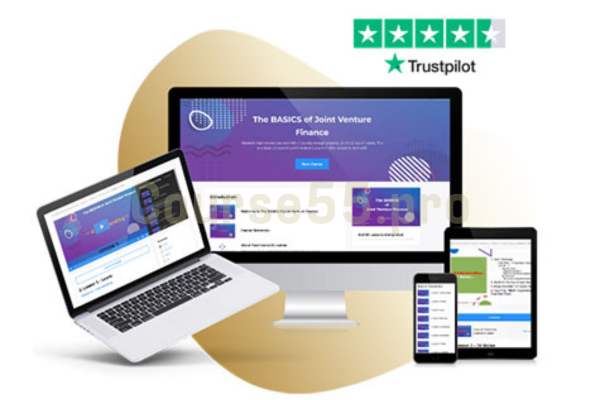The BASICS of Joint Venture Finance By Paul Smith
$1,319.00 Original price was: $1,319.00.$155.00Current price is: $155.00.
Download The BASICS of Joint Venture Finance By Paul Smith, check content proof here:
Paul Smith’s The Fundamentals of Joint Venture Finance
It may be both thrilling and risky to navigate the waters of commercial alliances, much like navigating a ship through unknown waters. Paul Smith expertly clarifies the fundamental ideas and financial factors required for establishing and running profitable joint ventures in The Basics of Joint Venture Finance. This work offers a thorough discussion of capital contributions and profit-sharing plans, highlighting the significance of mutual trust, clarity, and strategic alignment amongst partners. Understanding these fundamental components becomes essential for success and sustainability as entrepreneurs and firms work to maximize the synergy of united efforts.
Comprehending Joint Ventures
Joint ventures are strategic partnerships in which two or more people work together on a business project while sharing resources, risks, and profits. These kinds of arrangements are frequently compared to dancing, where both partners must move in unison to accomplish a shared objective. Paul Smith emphasizes how crucial the financial underpinnings of such endeavors are to navigating the opportunities and difficulties.
Important Elements of Joint Ventures:
- Capital Contributions: Each partner typically invests capital into the joint venture, which could be monetary or in-kind contributions such as assets or technology. The agreement should stipulate how much each partner is expected to contribute and the timeline for these contributions.
- Profit-Sharing Arrangements: Profit distribution can be challenging; it may depend on the initial contributions or mutual agreements on percentages. Smith underscores the need for transparent mechanisms to avoid disputes down the road.
- Legal Framework: Establishing a strong legal foundation is like laying concrete for a house; it supports the entire structure. Joint ventures require clear legal contracts that outline the rights, responsibilities, and obligations of each partner. This helps in mitigating conflicts and misunderstandings.
Since couples frequently have different expectations and histories, navigating these factors can be challenging. According to Smith, a successful collaboration depends on finding common ground through thorough agreements.
The Value of Unambiguous Agreements
The success or failure of joint ventures can be determined by the clarity of agreements and communication. Paul Smith stresses the importance of creating thorough contracts that eliminate all possibility of misunderstanding. Businesses must have well-defined agreements to direct their pathways, just as a sailor requires a well-drafted map to successfully navigate through choppy waters.
The advantages of explicit agreements
- Risk Mitigation: A thorough contract reduces the possibility of miscommunications that can result in legal issues. With a strong agreement on how to handle different situations, partners may tackle obstacles.
- Building Trust: A successful partnership is built on mutual trust, which is fostered when both parties are aware of what to expect. One way to think of trust is as the ship that transports the joint venture to its final destination.
- Efficiency: Decision-making is streamlined by clearly defined roles and duties, freeing up partners to concentrate on the expansion and success of the business rather than settling disputes.
Components to Include in Joint Venture Agreements:
- Terms of Operation: Outline the governance structure, management responsibilities, and decision-making processes.
- Financial Arrangements: Clearly state profit-sharing models, capital contributions, and mechanisms for reinvestment.
- Exit Strategies: Discuss conditions under which partners may exit the venture, ensuring procedures are in place for smooth transitions.
By weaving these elements into the fabric of the joint venture agreement, parties can cultivate a nurturing environment for their business synergy.
Assessing Hazards and Strategic Coherence
Assessing possible risks in the context of joint ventures is similar to storm preparation; one needs to be aware of and make plans for probable unforeseen circumstances. Paul Smith talks about how crucial it is to evaluate partners’ strategic alignment in addition to their financial risks. Without a thorough risk assessment, a partnership may experience unanticipated turbulence.
Important Topics for Risk Assessment:
Market Risks: Take into account how market needs, competitive environments, and economic swings could impact the joint venture’s success.
Operational Risks: Consider differences in operational efficiencies while assessing each partner’s capacity to achieve common goals.
Financial Risks: Examine the possibility of monetary losses and make backup plans that will let the business continue even in the face of difficult financial conditions.
A Look at Strategic Alignment:
- Shared Goals: In order to sail smoothly toward shared goals, all parties should preferably have aligned visions for the future.
- Strengths that complement each other: Establishing a joint venture with partners whose strengths complement one another can maximize strengths and reduce weaknesses, much like a well-tuned orchestra.
- Cultural Fit: Conflicts may arise from disparities in workplace cultures. Discord can be avoided by ensuring that partners maintain compatible work styles and values.
Partners build a strong basis for their joint venture by taking a proactive approach to risk assessment and guaranteeing strategic alignment.
Financial Projections and Management
Financial projections illustrate the future potential of the joint venture, serving as a lighthouse guiding partners through foggy business seas. This aspect of joint venture finance is fundamental, particularly because it highlights the economic viability of the collaboration. Paul Smith stresses the necessity of developing accurate and realistic financial forecasts, as they directly influence decision-making and strategic planning.
Financial Projections’ Components:
- Revenue Forecasts: Analyzing anticipated earnings from multiple sources of income might reveal information about the venture’s financial stability. A thorough examination can be provided by a variety of scenarios, such as optimistic and conservative forecasts.
- Cost Structures: It’s important to comprehend both fixed and variable expenses. Creating a thorough budget facilitates monitoring financial performance in relation to projections.
- Analysis of Break-Even: Partners can learn when they might begin to generate profits by figuring out the break-even point, or the amount of sales required to cover costs.
Financial Management Strategies:
- Regular Monitoring: Continuously assessing financial performance against projections keeps partners engaged and informed.
- Adaptation: Be ready to adapt financial strategies in response to market changes, ensuring the joint venture remains agile.
- Transparent Reporting: Establishing a reporting mechanism reinforces trust and facilitates informed decision-making among partners.
In this way, effective financial management acts as both compass and anchor, ensuring partners are well-equipped to navigate the unpredictable waters of joint ventures.
In conclusion
Paul Smith’s explanation of the joint venture finance process serves as a reminder of the fine balance needed to maintain business ties. While risk assessment and strategy alignment guarantee that partners stay together in their pursuit of common goals, clear agreements offer the framework required to foster mutual trust. Businesses can not only survive but also prosper in the cooperation that joint ventures generate if they make a commitment to careful financial management and encourage open communication. In the end, the ideas covered in The Basics of Joint Venture Finance are essential road signs for anybody wishing to investigate these potent corporate alliances.

Frequently Asked Questions:
Business Model Innovation:
Embrace the concept of a legitimate business! Our strategy revolves around organizing group buys where participants collectively share the costs. The pooled funds are used to purchase popular courses, which we then offer to individuals with limited financial resources. While the authors of these courses might have concerns, our clients appreciate the affordability and accessibility we provide.
The Legal Landscape:
The legality of our activities is a gray area. Although we don’t have explicit permission from the course authors to resell the material, there’s a technical nuance involved. The course authors did not outline specific restrictions on resale when the courses were purchased. This legal nuance presents both an opportunity for us and a benefit for those seeking affordable access.
Quality Assurance: Addressing the Core Issue
When it comes to quality, purchasing a course directly from the sale page ensures that all materials and resources are identical to those obtained through traditional channels.
However, we set ourselves apart by offering more than just personal research and resale. It’s important to understand that we are not the official providers of these courses, which means that certain premium services are not included in our offering:
- There are no scheduled coaching calls or sessions with the author.
- Access to the author’s private Facebook group or web portal is not available.
- Membership in the author’s private forum is not included.
- There is no direct email support from the author or their team.
We operate independently with the aim of making courses more affordable by excluding the additional services offered through official channels. We greatly appreciate your understanding of our unique approach.
Be the first to review “The BASICS of Joint Venture Finance By Paul Smith” Cancel reply
You must be logged in to post a review.

 Product Marketing Certified: Core By Product Marketing Alliance
Product Marketing Certified: Core By Product Marketing Alliance  Geriatric Certification Course: Dementia, Medication, Wound, Fall & Nutrition Updates
Geriatric Certification Course: Dementia, Medication, Wound, Fall & Nutrition Updates 














Reviews
There are no reviews yet.